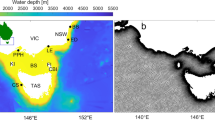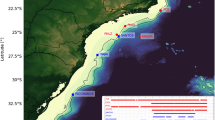Abstract
In this paper, we investigate changes in the wave climate of the west-European shelf seas under global warming scenarios. In particular, climate change wind fields corresponding to the present (control) time-slice 1961–2000 and the future (scenario) time-slice 2061–2100 are used to drive a wave generation model to produce equivalent control and scenario wave climate. Yearly and seasonal statistics of the scenario wave climates are compared individually to the corresponding control wave climate to identify relative changes of statistical significance between present and future extreme and prevailing wave heights. Using global, regional and linked global–regional wind forcing over a set of nested computational domains, this paper further demonstrates the sensitivity of the results to the resolution and coverage of the forcing. It suggests that the use of combined forcing from linked global and regional climate models of typical resolution and coverage is a good option for the investigation of relative wave changes in the region of interest of this study. Coarse resolution global forcing alone leads to very similar results over regions that are highly exposed to the Atlantic Ocean. In contrast, fine resolution regional forcing alone is shown to be insufficient for exploring wave climate changes over the western European waters because of its limited coverage. Results obtained with the combined global–regional wind forcing showed some consistency between scenarios. In general, it was shown that mean and extreme wave heights will increase in the future only in winter and only in the southwest of UK and west of France, north of about 44–45° N. Otherwise, wave heights are projected to decrease, especially in summer. Nevertheless, this decrease is dominated by local wind waves whilst swell is found to increase. Only in spring do both swell and local wind waves decrease in average height.












Similar content being viewed by others
Abbreviations
- AGCM:
-
Atmospheric Global Climate Model
- AR4:
-
Assessment Report 4
- CERA:
-
Climate and Environmental Retrieval and Archive
- CLM:
-
Climate Local Model
- ECHAM5:
-
5th Generation of Global Climate Model developed by the Max Planck Institute for Meteorology
- ETOP01:
-
1 arc-minute global relief model of Earth’s surface that integrates land topography and ocean bathymetry
- GCM:
-
Global Climate Model
- GEV:
-
Generalized Extreme Value
- IPCC:
-
Intergovernmental Panel on Climate Change
- MPI-M:
-
Max Planck Institute for Meteorology
- NCEP:
-
National Centers for Environmental Prediction
- NGDC:
-
National Geophysical Data Center
- NOAA:
-
National Oceanic and Atmospheric Administration
- RCM:
-
Regional Climate Model
- RLP:
-
Return Level Plot
- SLP:
-
Sea Level Pressure
- SRES:
-
Special Report on Emissions Scenarios
- STOWASUS-2100:
-
Research Project: regional STOrm WAve and SUrge Scenarios for the 2100 century
- SWRDA:
-
South West Regional Development Agency UK
- UKCIP:
-
UK Climate Impacts Programme
- WAM:
-
WAve Model
- WAMDI:
-
Work Group for WAM model
- WASA:
-
Research Project: Waves and Storms in the North Atlantic
- WDCC:
-
World Data Center for Climate
- WMO:
-
World Meteorological Organization
- WW3:
-
Wave Watch III model
References
Andrade C, Pires H, Silva P, Taborda R, Freitas MC (2006). Zonas costeiras. In: Santos FD, Miranda P (eds.). Alteraҫões climáticas em Portugal. Cenários, impactos e medidas de adaptaҫão. Lisboa, Portugal, Gradiva. pp. 159–208
Andrade C, Pires HO, Taborda R, Freitas MC (2007) Projecting future changes in wave climate and coastal response in Portugal by the end of the 21st century. J Coast Res 50:263–257
Beniston M, Stephenson DB, Christensen OB, Ferro CAT, Frei C, Goyette S, Halsnaes K, Holt T, Jylha K, Koffi B, Palutikof J, Scholl R, Semmler T, Woth K (2007) Future extreme events in European climate: an exploration of regional climate model projections. Clim Change 81(Supplement 1):71–95
Bouws E, Jannink D, Komen G (1997) The increasing wave height in the North Atlantic Ocean. Bull Am Meteorol Soc 77(10):2275–2277
Caires S, Swail VR, Wang XL (2006) Projection and analysis of extreme wave climate. J Climate 19(21):5581–5605
Cardone V, Jensen R, Resio D, Swail V, Cox A (1996) Evaluation of contemporary ocean wave models in rare extreme events: the “Halloween storm” of October 1991 and the “Storm of the century” of March 1993”. J Atmos Oceanic Technol 13:198–230
Castro CL, Pielke RA Sr, Leoncini G (2005) Dynamical downscaling: assessment of value retained and added using the Regional Atmospheric Modelling System (RAMS). J Geophys Res 110:D05108. doi:10.1029/2004JD004721
Chawla A, Tolman HL (2007) Automated grid generation for WAVEWATCH III. NOAA/NWS/NCEP/OMB, Technical Note 254. p 71
Debernard J, Røed LP (2008) Future wind, wave and storm surge climate in the Northern Seas: a revisit. Tellus A 60(3):427–438
Debernard J, Sætra Ø, Røed LP (2002) Future wind, wave and storm surge climate in the northern North Atlantic. Climate Res 23:39–49
Feser F (2006) Enhanced detectability of added value in limited-area model results separated into different spatial scales. Mon Weather Rev 134:2180–2190
Fowler HJ, Blenkinsop S, Tebaldi C (2007) Linking climate change modelling to impacts studies: recent advances in downscaling techniques for hydrological modelling. Int J Climatol 27:1547–1578
Freund JE (1992) Mathematical statistics. Prentice-Hall, New Jersey, 576
Grabemann I, Weisse R (2008) Climate change impact on extreme wave conditions in the North Sea: an ensemble study. Ocean Dyn 58(3–4):199–212
Gulev SK, Hasse L (1999) Changes in wind waves in the North Atlantic over the last 30 years. Int J Climatol 19:1091–1117
Hanson JL, Tracy BA, Tolman HL, Scott DR (2009) Pacific hindcast performance of three numerical wave models. J Atmos Oceanic Technol 26(8):1614–1633
Harold JM, Bigg GR, Turner J (1999) Mesocyclone activity over the Northeast Atlantic. Part 2: an investigation of causal mechanisms. Int J Climatol 19(12):1283–1299
Hawkes PJ, Bagenholm C, Gouldby BP, Ewing J (1997) Swell and bi-modal wave climate around the coast of England and Wales. Report SR 409, HR Wallingford
Hollweg H-D, Fast I, Hennemuth B, Keupthiel E, Lautenschlager M, Legutke S (2008) Ensemble simulations over Europe with the regional climate model CLM forced with IPCC AR4 global scenarios. M&D Technical Report No. 3, Hamburg
Holthuijsen LH (2007) Waves in oceanic and coastal waters. Cambridge University Press, Cambridge, p 404
IPCC AR4 (2007) Climate change 2007. Fourth assessment report of the intergovernmental panel on climate change. Cambridge University Press, Cambridge
IPCC SRES (2000) Special report on emissions scenarios (SRES). A special report of working group III of the intergovernmental panel on climate change. Cambridge University Press, Cambridge, p 559
Kaas E, Andersen U (2000) Scenarios for extra-tropical storm and wave activity: methodologies and results. ECLAT-2 blue workshop, climate scenarios for water related and coastal impact. KNMI, Netherlands
Kaas E, Andersen U, Flather RA, Willimas JA, Blackman DL, Lionello P, Dalan F, Elvini E, Nizzero A, Malguzzi P, Pfizenmayer A, von Storch H, Dillingh D, Phillipart M, de Ronde J, Reistad M, Midtbø KH, Vignes O, Haakenstad H, Hackett B, Fossum I, Sidselrud L (2001) Synthesis of the STOWASUS-2100 project: regional storm, wave and surge scenarios for the 2100 century. Danish Climate Centre Report 01–3. p 27
Kriezi EE, Broman B (2008) Past and future wave climate in the Baltic Sea produced by the SWAN model with forcing from the regional climate model RCA of the Rossby Centre. In: IEEE/OES US/EU-Baltic International Symposium (ed.), Tallinn, Estonia, 27–29 May 2008. pp 360–366
Li Y, Simmonds DJ, Reeve DE (2008) Quantifying uncertainty in extreme values of design parameters with resampling techniques. Ocean Eng 35(10):1029–1038
Lowe JA, Howard TP, Pardaens A, Tinker J, Holt J, Wakelin S, Milne G, Leake J, Wolf J, Horsburgh K, Reeder T, Jenkins G, Ridley J, Dye S, Bradley S (2009) UK climate projections science report: marine and coastal projections. Met Office Hadley Centre, Exeter
Mearns LO, Rosenweig C, Goldberg R (1997) Mean and variance change in climate scenarios: methods, agricultural applications, and measures of uncertainty. Clim Change 35:367–396
Muraleedharan G, Rao AD, Kurup PG, Unnikrishnan Nair N, Mourani S (2007) Modified Weibull distribution for maximum and significant wave height simulation and prediction. Coastal Eng 54(8):630–638
NCEP (2006). National Center for Environmental Prediction, Washington DC. Available at: http://polar.ncep.noaa.gov/waves/NEW-WAM.html
NGDC (2009). National Geophysical Data Centre. Available at: http://www.ngdc.noaa.gov/mgg/global/global.html
Padilla-Hernádez R, Perrie W, Toulany B, Smith PC, Zhang W, Jimenez-Hernández S (2004) Intercomparison of modern operational wave models. In: 8th International workshop on wave hindcasting and forecasting, North Shore, Oahu, Hawaii
Pryor SC, Barthelmie RG, Kjellström E (2005) Potential climate change impact on wind energy resources in northern Europe: nalyses using a regional climate model. Climate Dyn 25:815–835
Räisänen J, Hansson U, Ullerstig A, Döscher R, Graham LP, Jones C, Meier M, Samuelsson P, Willén U (2003) GCM driven simulations of recent and future climate with the Rossby Centre coupled atmosphere—Baltic Sea regional climate model RCAO. RMK No.101, Rossby Centre, SMHI
Räisänen J, Hanson U, Ullerstig A, Döscher R, Graham LP, Jones C, Meier HEM, Samuelsson P, Willén U (2004) European climate in the late twenty-first century: regional simulations with two driving global models and two forcing scenarios. Climate Dyn 22:13–31
Roeckner, Baeuml G, Bonaventura L, Brokopf R, Esch M, Giorgetta M, Hagemann S, Kirchner I, Kornblueh L, Manzini E, Rhodin A, Schlese U, Schulzweida U, Tompkins A (2003) The atmospheric general circulation model ECHAM 5. PART I: model description. MPI-Report 349
Sotillo M, Ratsimandresy A, Carretero J, Bentamy A, Valero F, Gonzalez-Rouco F (2005) A high-resolution 44-year atmospheric hind-cast for the Mediterranean basin: contribution to the regional improvement of global reanalysis. Climate Dyn 25(2–3):219–236
Thompson P, Reeve DE, Stander J, Cai Y (2009) Automated threshold selection methods for extreme wave analysis. Coastal Eng 56(10):1013–1021
Tolman (2002a) User manual and system documentation of WAVEWATCH-III version 2.22. NCEP/NOAA/NWS, National Center for Environmental Prediction, Technical note 222, Washington
Tolman HL (2002b) Validation of WAVEWATCH III version 1.15 for a global domain. NCEP/NOAA/NWS, National Center for Environmental Prediction, Technical note 213, Washington
Tolman HL (2003) Treatment of unresolved islands and ice in wind wave models. Ocean Model 5:219–231
van Heteren J, Bruinsma J (1981) A method to calculate the probability of exceedance of the design wave height. Coastal Eng 5:83–91
van Ulden AO, van Oldenborgh GJ (2006) Large-scale atmospheric circulation biases and changes in global climate model simulations and their importance for climate change in Central Europe. Atmos Chem Phys 6:863–881
van Ulden A, Lenderink G, van den Hurk B, van Meijgaard E (2007) Circulation statistics and climate change in Central Europe: PRUDENCE simulations and observations. Clim Change 81:179–192
WAMDI (1988) The WAM model—a third generation ocean wave prediction model. J Phys Oceanogr 18:1775–1810
Wang XLL, Swail VR (2006) Climate change signal and uncertainty in projections of ocean wave heights. Climate Dyn 26(2–3):109–126
Wang XLL, Zwiers FW, Swail VR (2004) North Atlantic Ocean wave climate change scenarios for the twenty-first century. J Climate 17(12):2368–2383
WASA (1998) Changing waves and storms in the Northeast Atlantic? Bull Am Meteorol Soc 79:741–760
WDCC (2009). World Data Centre for Climate, CERA-DB. Available at: http://cera-www.dkrz.de/
Winterfeldt J, Weisse R (2009) Assessment of value added for surface marine wind speed obtained from two regional climate models. Mon Weather Rev 137:2955–2965
WMO (1998) Guide to wave analysis and forecasting. WMO-No. 702. Secretariat of the world meteorological organization, Geneva, Switzerland
Acknowledgements
The climate change experiments used in this work are supplied from the Max Planck Institute for Meteorology and are retrieved from the WDCC/CERA database (WDCC 2009). The authors acknowledge the support of UK South West Regional Development Agency (SWRDA) through grant no. SWR01011. We would also like to thank Dr. Julian Stander (School of Mathematics and Statistics, University of Plymouth) for his valuable advice on the statistical analysis of this work.
Author information
Authors and Affiliations
Corresponding author
Additional information
Responsible Editor: Roger Proctor
Rights and permissions
About this article
Cite this article
Zacharioudaki, A., Pan, S., Simmonds, D. et al. Future wave climate over the west-European shelf seas. Ocean Dynamics 61, 807–827 (2011). https://doi.org/10.1007/s10236-011-0395-6
Received:
Accepted:
Published:
Issue Date:
DOI: https://doi.org/10.1007/s10236-011-0395-6




